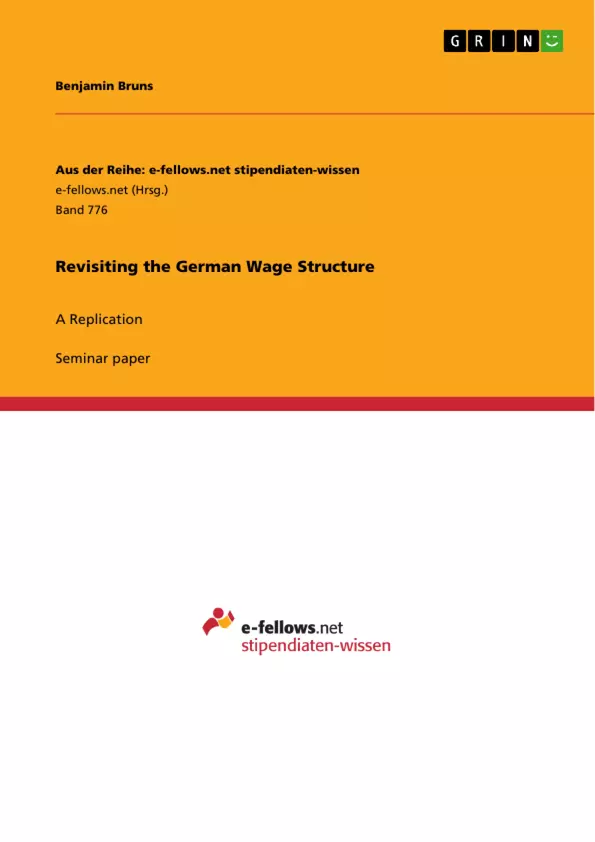Using a large administrative data set, a recent study by Dustmann, Ludsteck, and Schönberg [2009] finds convincing evidence for rising wage inequality in West Germany during the past three decades. Their paper shows that the increase occurred above the median during the 1980s, and was augmented by rising inequality below the median in the 1990s. These results challenge the pervasive conception of the German wage structure being a paragon of stability.
Within the scope of this seminar paper, I replicate parts of their analysis using a different data set, namely the German Socio-Economic Panel (GSOEP) for the period from 1984 to 2009. Using monthly and hourly earnings constructs, I assess the extent to which the results of Dustmann, Ludsteck, and Schönberg [2009] can be recovered from GSOEP data. I do so by exploring the wage distribution along several dimensions. In addition to this, I analyze composition-constant counterfactual wage densities using the kernel density reweighting method advanced by DiNardo, Fortin, and Lemieux [1996]. A provisional evaluation of my results suggests that I can confirm the majority of findings of the original paper along a qualitative dimension. A quantitative assessment, however, reveals considerable deviations.
Inhaltsverzeichnis (Table of Contents)
- I. INTRODUCTION
- II. DATA DESCRIPTION
- a. The Data
- b. Sample Selection
- c. Construction of Variables
- III. EMPIRICAL INVESTIGATION
- a. Measures of Wage Inequality
- b. Kernel Density Reweighting
- IV. SUMMARY AND CONCLUSIONS
Zielsetzung und Themenschwerpunkte (Objectives and Key Themes)
This seminar paper aims to replicate and expand upon the findings of a study by Dustmann, Ludsteck, and Schönberg [2009] regarding the changing German wage structure. The objective is to analyze the extent to which their results can be replicated using a different data set, namely the German Socio-Economic Panel (GSOEP). Key themes explored in the paper include:- Rising wage inequality in Germany during the 1980s and 1990s
- The role of unionization and de-unionization in influencing wage inequality
- The impact of skill-biased technological change on wage distribution
- The comparison of findings derived from different data sources
- The use of kernel density reweighting to account for compositional changes in the workforce
Zusammenfassung der Kapitel (Chapter Summaries)
I. INTRODUCTION
This chapter introduces the topic of secular changes in wage and income distribution, emphasizing its relevance for labor economics and policy debates. It reviews existing literature on wage inequality, highlighting trends observed in the United States and other developed countries, particularly during the 1980s and 1990s. The chapter also discusses the perception of Germany as a country with a stable wage structure, and how recent research challenges this view.II. DATA DESCRIPTION
This section delves into the data used in the analysis, primarily the GSOEP. It compares the GSOEP with the data used in the original study by Dustmann, Ludsteck, and Schönberg, and discusses the sample selection and variable construction used for the replication.III. EMPIRICAL INVESTIGATION
This section presents the empirical findings of the replication study. It examines various measures of wage inequality, highlighting the similarities and differences between the GSOEP data and the original study's findings. The chapter also introduces and applies the kernel density reweighting method to account for compositional changes in the workforce.IV. SUMMARY AND CONCLUSIONS
This section summarizes the findings of the seminar paper and provides concluding remarks. It discusses the implications of the replication study, the strengths and limitations of the GSOEP data, and potential avenues for further research.Schlüsselwörter (Keywords)
This paper focuses on the German wage structure, examining trends in wage inequality during the 1980s and 1990s. Key concepts include unionization, de-unionization, skill-biased technological change, data replication, and kernel density reweighting. The study utilizes data from the German Socio-Economic Panel (GSOEP), comparing its findings to those of previous research using a different dataset, specifically the Institute for Employment Research (IABS) data.- Citation du texte
- Benjamin Bruns (Auteur), 2013, Revisiting the German Wage Structure, Munich, GRIN Verlag, https://www.grin.com/document/232030



